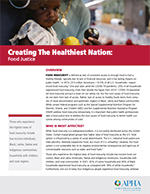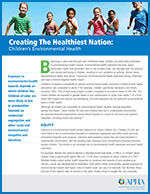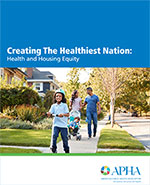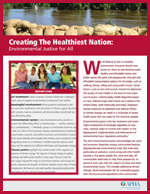Creating health equity is a guiding priority and core value of APHA. By health equity, we mean everyone has the opportunity to attain their highest level of health.
What is Health Equity?
Latest Updates
Advancing Health Equity for People with Intellectual Disabilities
APHA is proud to have received an inclusive health subgrant from the Special Olympics to highlight the unique experiences of people with intellectual disabilities and identify promising strategies for advancing health equity within this community. As part of this work, APHA will be convening an advisory board, hosting a panel during National Public Health Week, drafting an issue brief and publishing a supplement in The Nation’s Health. If you would like to learn more about this exciting work, please visit our Disability and Health webpage.
APHA Health Equity Fact Sheets, Briefs, Reports and Infographics
 COVID-19 Vaccination: An Equitable Response urges equity as a priority to curb the pandemic's devastation on communities of color.
COVID-19 Vaccination: An Equitable Response urges equity as a priority to curb the pandemic's devastation on communities of color.
This fact sheet calls on reaching those at highest risk and most vulnerable and using data to determine those categories. Examples of how to build trust with communities include using frequent, transparent communication and by forging partnerships with community health workers and other trusted messengers.
Share the fact sheet in English (PDF) and Spanish (PDF)

COVID-19's Impact on Housing Instability offers a visual overview of how the pandemic has put millions more at risk of eviction.
Share our infographic to spread the word on how the problem has disproportionately impacted some communities and how public health can help.
 COVID-19's Impact on Health of the Unsheltered underscores how people experiencing unsheltered homelessness, especially those from marginalized communities, are at higher risk of COVID-19 illness and death.
COVID-19's Impact on Health of the Unsheltered underscores how people experiencing unsheltered homelessness, especially those from marginalized communities, are at higher risk of COVID-19 illness and death.
The infographic also gives recommendations on ways we in public health can help both now and over the long term.
 Creating the Healthiest Nation: Food Justice (PDF) explores food insecurity in the United States with an emphasis on the structural barriers that lead to disproportionate hunger and malnutrition in low-income communities and communities of color. The fact sheet highlights the impact of the COVID-19 on food security and recommends steps public health professionals can take at the local, state and federal levels to work towards the goal of food justice.
Creating the Healthiest Nation: Food Justice (PDF) explores food insecurity in the United States with an emphasis on the structural barriers that lead to disproportionate hunger and malnutrition in low-income communities and communities of color. The fact sheet highlights the impact of the COVID-19 on food security and recommends steps public health professionals can take at the local, state and federal levels to work towards the goal of food justice.

Creating the Healthiest Nation: Opportunity Youth (PDF) takes a look at the higher disease and premature death risks of disconnected youth — also referred to as opportunity
youth in recognition of the benefits made possible by a return to school or work and
the tremendous potential they hold.
The fact sheet highlights the toll of the COVID-19 pandemic on this population and offers solutions we can take at the local, state and federal levels to address youth disconnection.

Creating the Healthiest Nation: Children's Environmental Health (PDF) explains how exposure to environmental pollutants during childhood can have lifelong negative health impacts, including developmental delays and higher risks of cancer and asthma.
The fact sheet gives recommendations on combatting the existing disparities that worsen such health impacts for children of color and those who live in underserved communities. Those recommendations include enforcing routine testing and inspection of homes for such environmental hazards as radon, lead and mold.

Creating the Healthiest Nation: Health & Housing Equity (PDF) examines how structural racism and discriminatory policies led to housing and health inequality in America for low-income communities and people of color.
To equip public health professionals with the tools to address these inequities in their communities, the report outlines numerous ways to advance equitable change in housing equity through policy and advocacy, cross-sector partnerships and community engagement and education.
 Creating the Healthiest Nation: Water and Health Equity (PDF) discusses the root problems to access and affordable water in the United States today. The fact sheet also highlights several types of water contamination that deeply impact the health of the consumer, the connection between water and agriculture and climate change, how water quality will affect some more than others, as well as recommendations on what can be done to improve our status. (Updated August 2022)
Creating the Healthiest Nation: Water and Health Equity (PDF) discusses the root problems to access and affordable water in the United States today. The fact sheet also highlights several types of water contamination that deeply impact the health of the consumer, the connection between water and agriculture and climate change, how water quality will affect some more than others, as well as recommendations on what can be done to improve our status. (Updated August 2022)

Creating the Healthiest Nation: Advancing Health Equity (PDF) explains why health inequities hurt public health. The fact sheet outlines key principles for advancing health equity and takes a look at the role of such social determinants of health as housing, education, income and neighborhood conditions.

Creating the Healthiest Nation: Environmental Justice for All (PDF) defines such important terms as 'fair treatment' and 'environmental racism' and gives recommendations for advancing environmental justice. Among the key findings highlighted in the fact sheet: race is the strongest indicator for the placement of toxic facilities in the United States.
 Creating the Healthiest Nation: Health and Educational Equity (PDF) gives a snapshot of which students are most at risk for not graduating from high school. The fact sheet tells us how to advance health and educational equity through such efforts as offering group therapy, giving students access to washers and dryers and making sure school staff have ongoing opportunities for culturally informed professional development.
Creating the Healthiest Nation: Health and Educational Equity (PDF) gives a snapshot of which students are most at risk for not graduating from high school. The fact sheet tells us how to advance health and educational equity through such efforts as offering group therapy, giving students access to washers and dryers and making sure school staff have ongoing opportunities for culturally informed professional development.
More about health equity
Inequities are created when barriers prevent individuals and communities from accessing these conditions and reaching their full potential. Inequities differ from health disparities, which are differences in health status between people related to social or demographic factors such as race, gender, income or geographic region. Health disparities are one way we can measure our progress toward achieving health equity.
How do we achieve health equity? We value all people equally. We optimize the conditions in which people are born, grow, live, work, learn and age. We work with other sectors to address the factors that influence health, including employment, housing, education, health care, public safety and food access.1 We name racism as a force in determining how these social determinants are distributed.
As APHA Executive Director Georges Benjamin, MD, writes in this U.S. News & World Report piece, "Health equity is a goal we can achieve, and it's within our power to do so. We have the tools and the knowledge to make health equity happen, but it's up to all of us to use them."
From The Nation's Health
Special Section: Addressing health equity through state, regional partnerships
Climate change, health equity 'inextricably linked'
Complete streets promoting health equity in communities: Supporting transportation for all users
Health departments placing stronger emphasis on equity
More APHA Resources
Communications Strategies for Social Justice (Spanish)
All Health is Connected: Can Leveraging Women's Health Care Help Narrow Gaps in Black Men's Health? (APHA issue brief)
Climate Change, Health and Equity: A Guide for Local Health Departments
Health equity now: A state of play on public health and equity (from APHA's Public Health Newswire)
Fumes across the fence-line (from APHA's Public Health Newswire)
APHA's Georges Benjamin on "Closing the Gap on Health Disparities"
Better Health Through Equity: Case Studies in Reframing Public Health Work (PDF) highlights state and local efforts from health agencies and one Tribal Nation across Colorado, Oregon, Texas, Virginia and Wisconsin to address the root causes of health inequities.
Read APHA Executive Director Georges Benjamin's thoughts on health equity ("It is simply impossible to talk about the roles that racism and discrimination play in the health of our communities without taking a hard look inward...")
Partner Resources:
Learn More:
1 What are Health Disparities and Health Equity? We Need to Be Clear